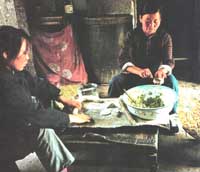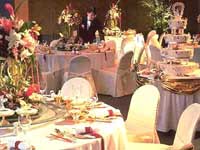So! The menu has been planned, the invitations have
been sent out, and the auspicious evening has finally arrived. The guests
come to the restaurant punctually, and the guest of honor is seated at the
table directly opposite the entrance to the room. The host sits directly
opposite the guest of honor with his back to the door. The tables are
generally round and seat ten, or occasionally twelve.
 The
Chinese relationship with food is as ancient and varied as the people
themselves.
The
Chinese relationship with food is as ancient and varied as the people
themselves.
Guests will find the table setting somewhat more
elaborate than usual, with a chopstick rest holding a silver spoon for
taking food from the dishes in the center of the table, as well as a pair
of chopsticks. Fine ivory or silver chopsticks were used in the past.
Silver had a special significance, for the Chinese believed it would turn
black if exposed to any form or poison. Thus, emperors and others who
feared assassination used silver utensils, or had a silver disc placed
inside each dish of food before it was presented to them.
Scented towels are handed to guests so they may refresh
themselves before the meal begins, and glasses of fragrant tea are poured.
The tea will be topped up throughout the meal, unless guests switch to a
stronger drink. Chinese wines have lost their popularity and these days
cognac is the preferred drink. Toasts, incidentally, start only with the
third course, but despite this, if guests are determined to embark on a
round of “yam sengs”, staying sober after downing several large
glasses of neat cognac is a real challenge.
 Not
all Chinese kitchens are as primitive as this one; however, most homes
cannot accommodate a lavish banquet.
Not
all Chinese kitchens are as primitive as this one; however, most homes
cannot accommodate a lavish banquet.
Chinese attitudes towards alcohol have always been
fairly relaxed, and to be slightly tipsy is not a disgrace. However, to be
thoroughly drunk is frowned upon. In the worlds of Confucius, “There is
no limit to the drinking of the wine.” In Singapore and Hong Kong, the
shout of “yam seng” is a signal for all the men to stand up and drain
their glasses in one gulp.
The ten courses of the dinner come in reasonably quick
succession. Each dish is set down in the center of the table for everyone
to help themselves (except in the case of the soup, which is served by the
waitress). It is considered very polite to occasionally select a choice
morsel for the person sitting beside you or to place it on his or her
plate. There is no compulsion to eat part of every course, or for the
guests to finish every dish presented. Those unaccustomed to banquets
learn, to their chagrin, that if they eat too heartily at the beginning,
they will not get beyond the sixth or seventh course.
 The
Chinese banquet room at Park Lane Hotel in Beijing.
The
Chinese banquet room at Park Lane Hotel in Beijing.
When the “yam sengs” have finished, the last glass
of tea is drained and the final refreshing towels have been brought
around, guests quickly depart. In private homes, this would be considered
extremely bad manners, but if the banquet is served in a restaurant, it is
customary to leave right after the dinner is over.
Perhaps some nostalgic Chinese think of the days when a
banquet was an all-night affair; when the strains of the ‘pi par’ and
the high pitched voices of the singers would be caught between the sounds
of laughter and animated conversation. In those days cultured gentlemen
would delight in lingering awhile over philosophical conversations while
attendants hurried back and forth across the lamp-lit courtyard between
kitchens and the banquet hall. Then guests would argue the merits of
painters and poets, or pass on their latest recipe for cooking eel with
bamboo shoots. The leisurely lifestyle of the past has disappeared. But
one vital aspect remains constant; the outstanding excellence of the food.

 The
Chinese relationship with food is as ancient and varied as the people
themselves.
The
Chinese relationship with food is as ancient and varied as the people
themselves. Not
all Chinese kitchens are as primitive as this one; however, most homes
cannot accommodate a lavish banquet.
Not
all Chinese kitchens are as primitive as this one; however, most homes
cannot accommodate a lavish banquet. The
Chinese banquet room at Park Lane Hotel in Beijing.
The
Chinese banquet room at Park Lane Hotel in Beijing.
